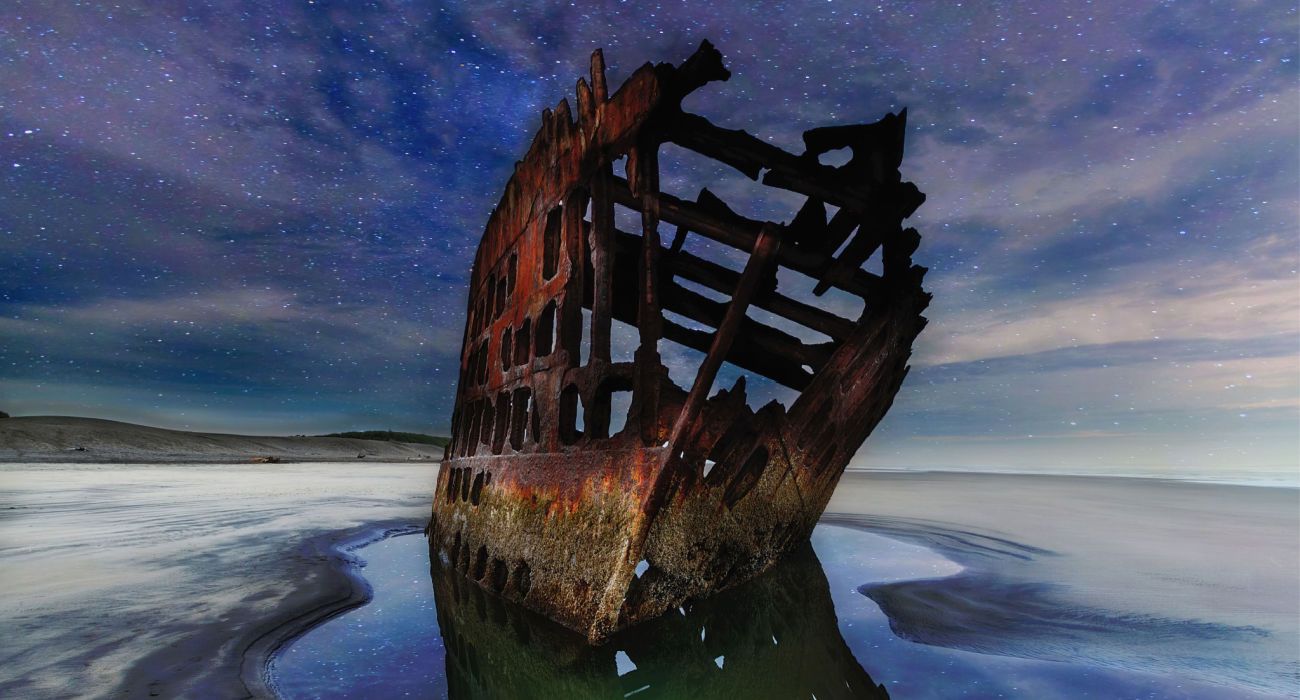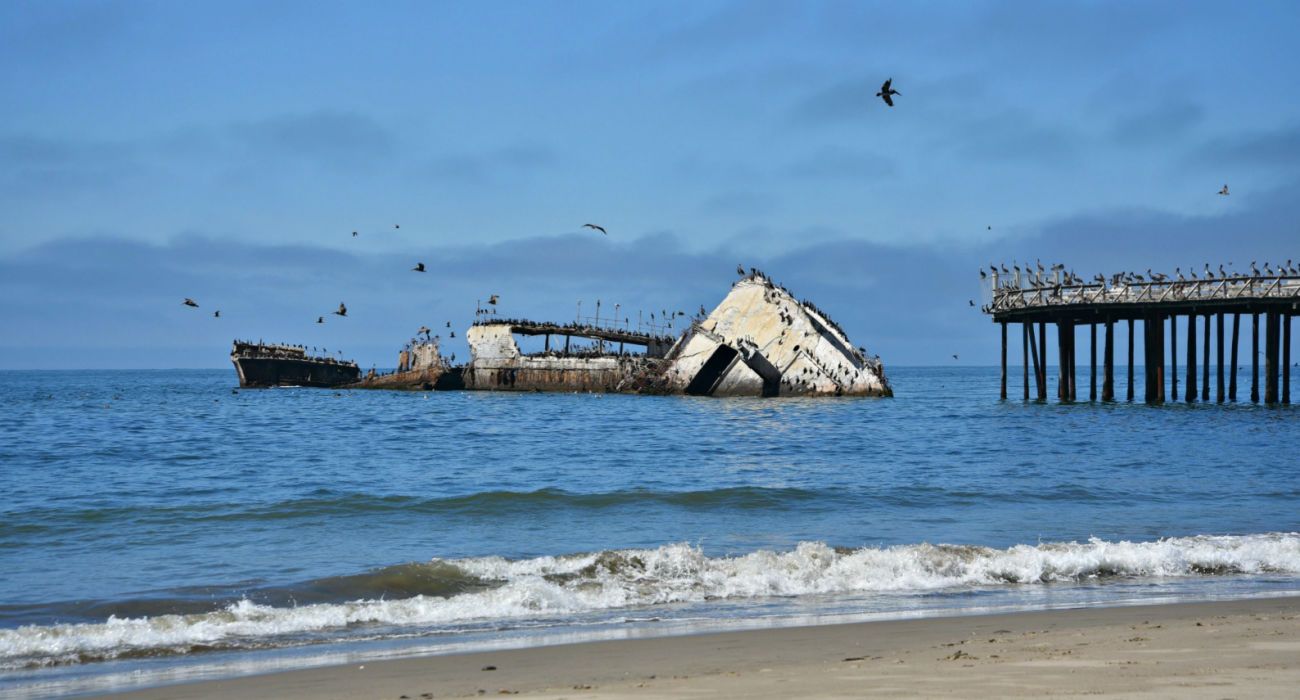Read update
- More To Know Of West Coast Wrecks & Ship Graveyards
Quick Links
The stretch of Pacific coastline from the northern tip of Canada's Vancouver Island south along the Washington State coastline to around Tillamook Bay on the Oregon Coast is notorious for being dangerous for shipping. So treacherous is it that it has earned itself the title "The Graveyard of the Pacific." The stretch of coastline includes the treacherous Columbia Bar and Juan de Fuca Strait.
The story of the Graveyard of the Pacific and Columbia Bar is fascinating - although few wrecks are visible today. One of the most spectacular places in the world to dive wrecks is the sunken Japanese fleet at Truk Lagoon in Micronesia. Perhaps the most extreme place in the world to dive wrecks is the sunken nuclear American fleet at Bikini Atoll.
UPDATE: 2023/01/19 18:05 EST BY AARON SPRAY
More To Know Of West Coast Wrecks & Ship Graveyards
While the graveyard of the Pacific may be in Oregon, there are wrecks to be found up and down the West Coast. This list was updated with more wrecks to discover while enjoying a West Coast road trip. Some of the wrecks can only be seen scuba diving (and some were sunk intentionally as ship dive sites).
The Treacherous Story Of The Graveyard Of The Pacific
The coastline that makes up the Graveyard of the Pacific is plagued with unpredictable weather, shifting sandbars, tidal rips, and rocky reefs. These have spelled the doom of thousands of ships since European exploration.
It is estimated that over 2,000 ships have been wrecked along The Graveyard of The Pacific. While the coastline is not as dangerous as it once was (thanks to, the Cape Disappointment Lighthouse, the North Head Lighthouse, GPS, etc.) it continues to claim ships and lives.
- Number Of Wrecks: Over 2,000
One of the most dangerous parts of the Graveyard of the Pacific is the Columbia Bar - a giant sandbar. Other particularly nasty landmarks are Cape Flattery, reefs and rocks along the west coast of Vancouver Island, and the Strait of Juan de Fuca.
Columbia Bar is one of the most dangerous bar crossings in the world. It is around 3 miles wide and 6 miles long.
The most accessible place to see the wrecks of Columbia Bar is at the South Jetty viewing platform at Oregon's Fort Stevens State Park. The South Jetty is located at the northern end of the Oregon Coast Trail. The park is also home to the only Civil War earthen fort found on the West Coast.
Alternatively, a more impressive view can be found at Cape Disappointment Lighthouse at Cape Disappointment State Park over the state line in Ilwaco, Washington. Visitors need to hike a steep 0.75 mile or 1.21 km trail to get to the lighthouse.
Notable Wrecks Of The Graveyard Of The Pacific
There are a number of important wrecks along the coast, although most are not visible or have broken up over the years. Some wrecks are:
- May 3, 1830, Isabella: A Supply Ship Sank Off Sand Island And Found In 1986, Now A Archeological Site And The Only One Of Its Kind
- July 18, 1841, Peacock: US Naval Brig
- January 15, 1909, Alice: A French Square-Rigged Ship Ran Aground With 3,000 Tons of Cement, Today It Can Occasionally Be Seen At Extreme Low Tides
- February 15, 1930, Admiral Benson: Sank In Heavy Fog & Located At Benson Beach, Partly Visible During Extreme Low Tides
- February 13, 1947, Arrow: Was An Army Ship And Then A Passenger Line In Hawaii. While Being Hauled To Astoria For Retirement, It Broke Loose In Bad Weather And Foundered. Its Masks Were Used As A War Memorial
- March 20, 1976, Bettie M: She Was Carrying 900 Tons Of Tuna When She Wrecked By The Cape Disappointment Lighthouse. The Wreck Is Occasionally Visible At Extreme Low Tides
Columbia Pacific Heritage Museum
One of the best places to go and learn about the Graveyard of the Pacific is the Columbia Pacific Heritage Museum. The museum is located at the confluence of the Columbia River and the Pacific Ocean in Ilwaco in Washington State.
The museum explores the history and culture of the region, tracing the history from the ancient Chinookan Culture through to today.
It explores the history of fishing, oystering, logging, tourism, and lifesaving in the region. It even has the historic Ilwaco Rail and Navigation Company’s Freight Depot used in the early 1900s as Ilwaco’s commercial transportation hub.
- Admission: Free For All Of 2022
Operating Hours:
- Open: 10.00 am to 4.00 pm (Wednesday to Saturday)
- Closed: Sunday, Monday, Tuesday
Visitors can also learn about the Graveyard of the Pacific around the Columbia River. Refer to the Columbia Pacific Heritage Museum's PDF guide, Shipwrecks Along The Discovery Trail.
Other Notable Wrecks To Be Found On The West Coast
So while the mouth of the Columbia River may be the Graveyard of the Pacific, there are not all that many wrecks easily visible. Fortunately, there are plenty more wrecks to be found all up and down the West Coast and some of these are quite accessible on a West Coast road trip.
Aptos: SS Palo Alto
One of the wrecks to call by going down the coast is the SS Palo Alto at Seacliff State Beach around Santa Cruz. The SS Palo Alto was a 420-foot-long oil tanker built for WW1. But the war ended before the ship was finished, and it was converted to a party ship. But its career as a party ship went bust and she was abandoned during the Great Depression. Today people can walk and see it (particularly at low tide) and see it gradually being broken apart by the waves and time.
- Date: Sunk the Early 1930s
- Location: Aptos, California
Salinas, California: Barge
While not exactly a ship, there is a barge to be found just off the Salinas River Wildlife Refuge Coast. It's not clear how and when it got there, but there it is. People can walk to the barge at low tide although at least some of it is visible all the time.
San Diego: Ruby E & HMS Yukon
Continue all the way down to San Diego and visitors can scuba dive the Ruby E. She was deliberately sunk in 1989, and it is today a noted diving site. She sits in water between 65 and 85 feet deep. Advanced divers are able to swim through some of the rooms of the ship.
Also in San Diego's Wreck Alley is the HMS Yukon. She was sunk in 2000 and is also a great place to go scuba diving. She was built as a Canadian destroyer, and today she is between 80 and 100 feet deep in the water.


